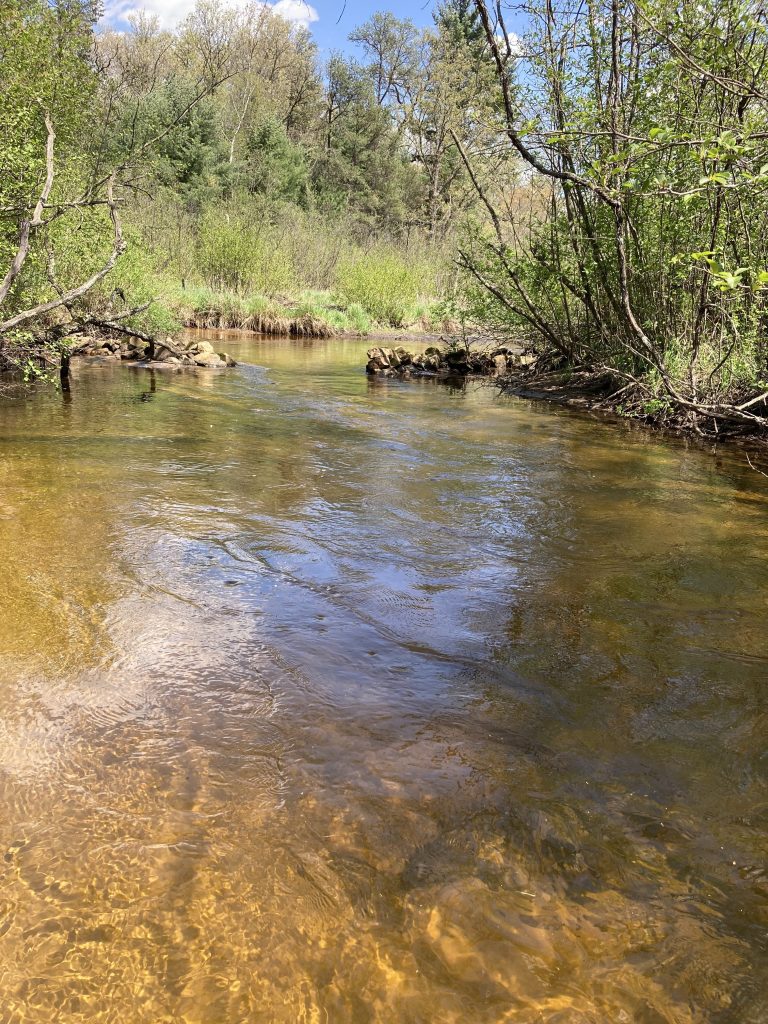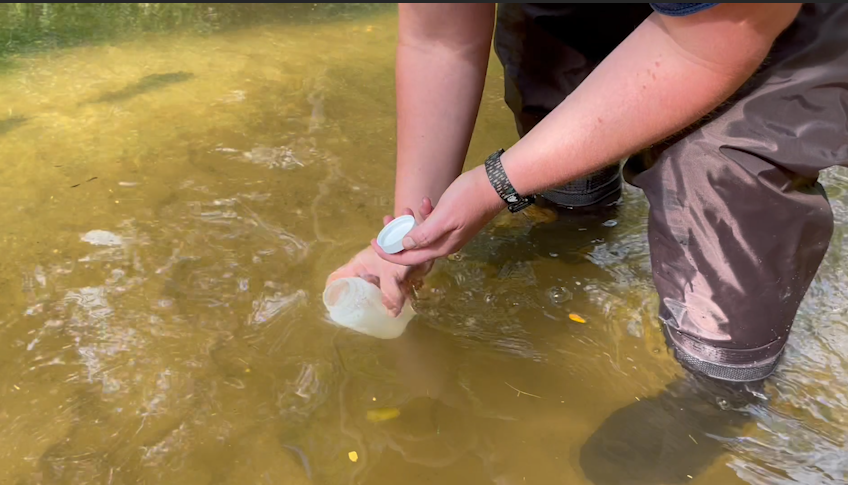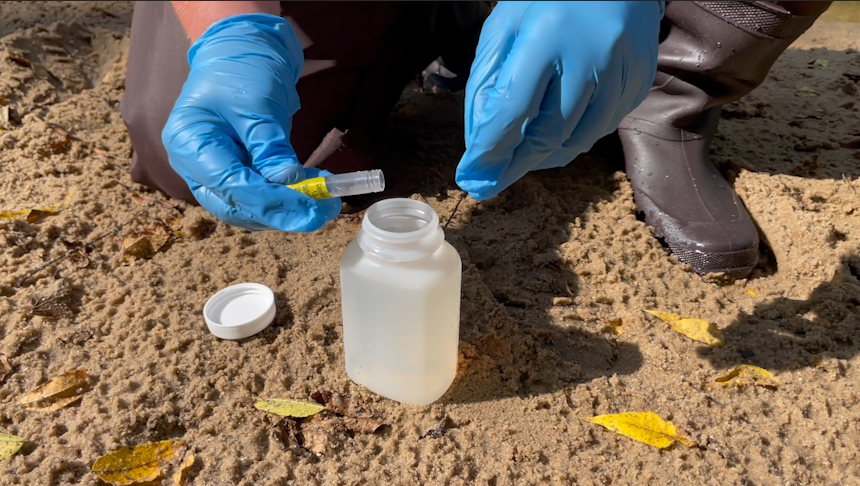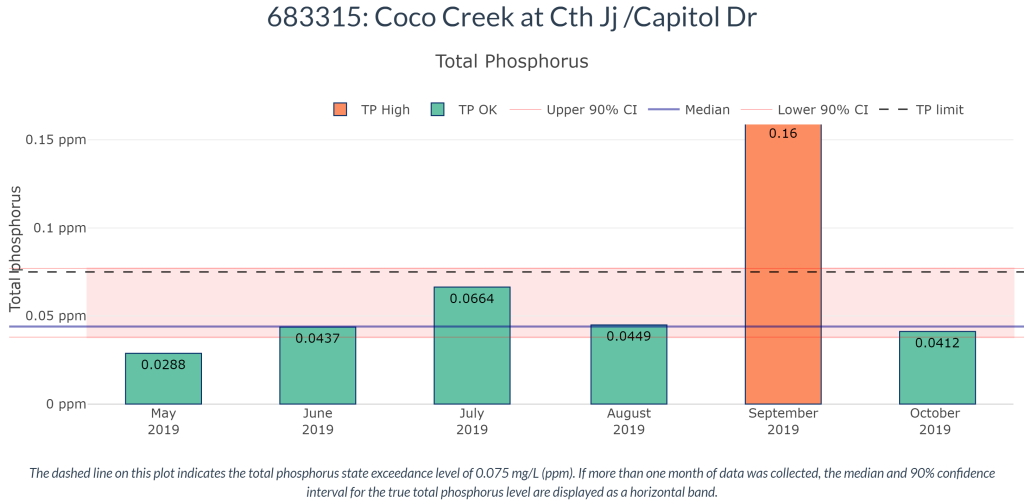Nutrient monitoring on Wisconsin’s waters: What does it all mean?
In addition to baseline monitoring, did you know some WAV volunteers also participate in monitoring nutrients on their streams? Depending on project needs in the area, some WAV volunteers assist Wisconsin Department of Natural Resources (DNR) staff and local WAV coordinators in collecting nutrient data on their streams. We recently met with DNR Streams Biologist, Camille Bruhn, to dig a little deeper into the importance of nutrient monitoring: why we do it, why we monitor for it, and finally – what does it all mean?
Buckle up for a trip into the world of nutrient monitoring.
What are nutrients?
Nutrients are chemical elements that all living organisms require to survive. Nutrients are essential for plant and animal growth. However, as the saying goes, “too much of a good thing can be a bad thing.” Nutrients, namely nitrogen and phosphorus, can come from natural sources such as soil, plant material, and wild animal waste. Before human development, many nutrients were able to be captured by forested spaces and wetlands before running off into aquatic ecosystems. With an increase in development and impervious surfaces, many sources of nutrients now come from human activities – fertilizers, run off, wastewater, and farm animal waste can all be sources of excess nutrients. When too many nutrients enter an aquatic system, it can spark algae blooms. Algae can turn the water green, smell bad, block sunlight, and even release toxins in some cases. When algae die, the process of decomposition uses dissolved oxygen. In some instances, increased nutrients can cause “hypoxic conditions” where there is not enough oxygen to sustain life.

Why is volunteer participation in nutrient monitoring important?
Volunteers provide valuable information when the biologists are busy during the summer months with other field work surveys. Their time is stretched thin, and having people on the landscape to collect data saves them time. Volunteers support biologists and local WAV coordinators by collecting data at sites chosen as a part of specific project. Additionally, nutrient concentrations in streams can be highly variable depending on natural variations in the amount and timing of precipitation, and changes in land management practices. Because of this it often requires multiple samples per year over (sometimes) many years to truly understand the current nutrient concentrations in a stream. Volunteers are valuable because they are often physically closer to these ecosystems than DNR staff and allow staff to focus their expertise on monitoring new streams instead of revisiting the same stream dozens of times.


What types of projects are nutrient testing useful for?
Nutrient testing is used to understand the interaction between the landscape and the streams that are formed by them. Nutrients are necessary and naturally occurring, but too many nutrients can have negative impacts on stream ecosystems. DNR projects that aim to understand stream health, such as Targeted Watershed Assessments, use nutrient testing combined with fish and habitat surveys and macroinvertebrate sampling in the watershed in order to give a more complete picture of the health and condition of the waters. Streams that fail to pass health checks are placed on the State’s Impaired Waters list. While it may take many years to improve stream condition, follow-up nutrient monitoring can help track progress towards watershed restoration goals and eventually remove streams from the 303(d) list of impaired waters. There are also long-term trend sites that receive monthly sampling in order to observe changes over a longer period of time.
What type of nutrients are tested?
WAV volunteers primarily test for total phosphorus, but in some projects may also collect samples for total suspended solids (i.e., sediment), dissolved phosphorus, and many different forms of nitrogen. Depending on the project, some will also test for chloride, algae, sulfate, metals, and E. coli. Samples are collected monthly, May – October.
What exactly are those parameters? Where do they come from, and what do they mean for the stream?
Total suspended solids: measure of the suspended solid particles within the water column. This is important because it tells the amount of solids coming off the landscape in the form of agricultural or urban runoff or resuspension from the stream banks and bottom. Solids within the water can cause clarity to be decreased and can settle out and impact fish and macroinvertebrate habitats by filling in or covering hard substrate such as gravel and cobble or stifling plant growth.
Total phosphorus (TP): measure of all forms of phosphorus, both dissolved and particulate. Phosphorus is a nutrient essential for plants and animals. TP can come from runoff, fertilizers, and wastewater, and can cause eutrophication and excessive plant and algae growth. Organic or sediment loads can be directly related to total phosphorus concentrations within streams. Total phosphorus is the one nutrient that Wisconsin has a state standard for. The criterion for total phosphorus is 0.075 mg/L in streams and 0.1 mg/L in large rivers. Total phosphorus concentrations can be compared to these criteria and can indicate if exceedances occur.
Dissolved phosphorus or soluble reactive phosphorus: measure of the dissolved portion of phosphorus within the water. This is important because the dissolved versus the particulate portion of phosphorus can help determine where the phosphorus is originating. Dissolved phosphorus comes from fertilizers and detergents and is available for direct uptake by plants, algae, and biota. High dissolved phosphorus concentrations can cause increased levels of plant and algae growth.
Total nitrogen: measure of all forms of nitrogen in a stream. Nitrogen is another nutrient essential for plants and animals. Nitrogen can come from wastewater, runoff from cropland or animal manure, and fertilizers. As with phosphorus, nitrogen can cause eutrophication and excessive plant and algae growth.
Ammonia: measure of a potentially toxic organic form of nitrogen. Under certain conditions, ammonia can be lethal to fish and other aquatic life. Ammonia is typically found in manure, but it is generally non-detectable in unpolluted environments. Ammonia concentrations can help determine if there are any impacts to fish and aquatic life in streams.
Nitrate-Nitrite as nitrogen: measure of an inorganic form of nitrogen that is typically expressed in surface waters as nitrate. As with total nitrogen, nitrate-nitrite comes from runoff and fertilizers. Nitrate can be elevated in highly agricultural areas due to manure or fertilizer use.
How is nutrient monitoring funded?
Water quality monitoring in Wisconsin is mainly funded through the US EPA’s Clean Water Act. Monitoring is funded through two different funding sources, one which requires Wisconsin to monitor and assess its surface waters to determine if they are healthy, such as meeting all applicable water quality standards. There is another funding source under the Clean Water Act that is specifically tied to evaluating improvements in water quality from the implementation of urban and agricultural restoration actions. Additional funding is provided by the US EPA and the Wisconsin Legislature for specific activities or tied to specific regions of the State (such as the Great Lakes).
How can I learn more about WAV nutrient monitoring?

Check out WAV’s data visualization dashboard: https://data-viz.it.wisc.edu/wav-dashboard/. It contains all the total phosphorus nutrient monitoring data from 2019-2021. Stay tuned for 2022 data, coming soon!